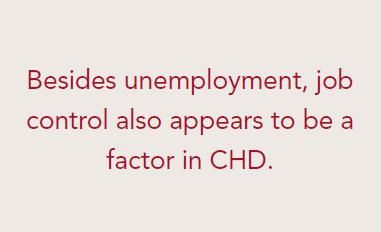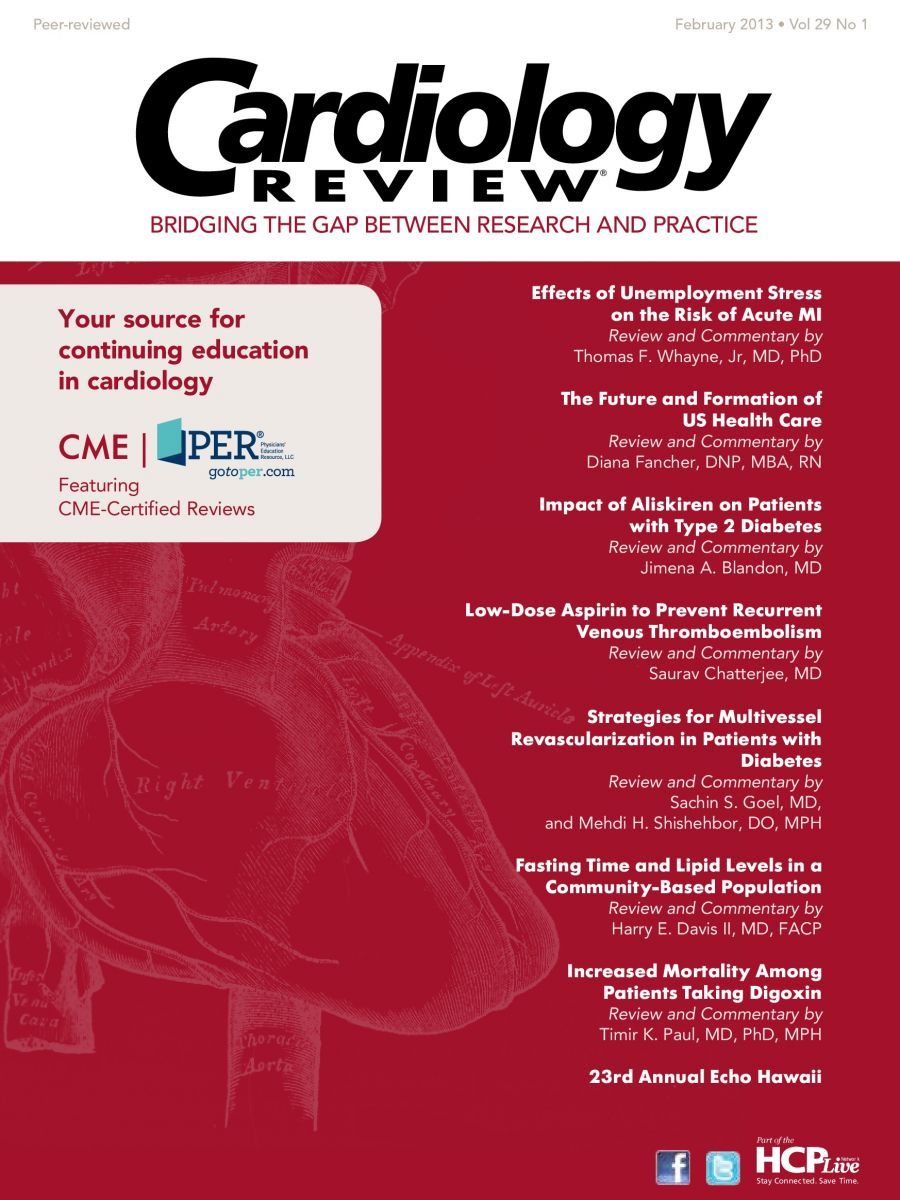Publication
Article
Cardiology Review® Online
Effects of Unemployment Stress on the Risk of Acute MI
Thomas F. Whayne, Jr, MD, PhD
Review
Study Design
In their study on unemployment’s effect on risks for acute myocardial infarction (AMI), Dupre et al

used statistical multivariate models to show that the risk for AMI was significantly higher among
unemployed individuals, with the risk especially elevated during the first year of unemployment.1 These significant results held even after adjustments for multiple clinical, socioeconomic, and behavioral risk factors.
The study population consisted of adults in a continuing prospective cohort study of adults aged 51 to 75 years in the Health and Retirement Study (HRS), which is sponsored by the National Institute on Aging and the Institute for Social Research at the University of Michigan in Ann Arbor. The analytic sample was described as including a total of 13,451 participants from the original HRS birth cohort (1931-1941), the war baby cohort (1942 to 1947), and the early baby-boomer cohort (1948 to 1953). The first interviews for the authors’ study on unemployment were carried out in 1992, 1998, and 2004, respectively. The participants in HRS on average contributed approximately 8 person-years of exposure during the 18-year study period, with a total of1061 AMI events or occurrences reported during 165,169 person-years of observation. This AMI incidence was 7.9% over the study period and it was the primary outcome analyzed. Participants in the study were asked at each biennial interview whether a “heart attack” or myocardial infarction had happened to them in the preceding approximately 24-month interval since the last interview. The authors considered that the relatively short interval between interviews and the seriousness of the evaluated events decreased the potential for recall bias.1
It was found that adults who had experienced an AMI were more likely to be males in an older age group, non-Hispanic, and to live in the South than those who did not suffer an event. The initial model showed that unemployment status, the cumulative number of job losses, and the cumulative time without employment were all associated with AMI. This was independent of other aspects of the patients’ work history. The fully adjusted model demonstrated an independent association with incident AMI as assessed by hazard ratio (HR) and confidence interval (CI). This association with incident AMI by work history was as follows: status as unemployed (HR, 1.35 [95% CI, 1.10-1.66]); 1 job loss (HR, 1.22 [95% CI, 1.04-1.42]); 2 job losses (HR, 1.27 [95% CI, 1.05-1.54]); 3 job losses (HR, 1.52 [95% CI, 1.22-1.90]); and 4 or more total job losses (HR, 1.63 [95% CI, 1.29-2.07]). These findings were significant and comparable to AMI association with other major risk factors such as smoking (HR, 1.44 [95% CI, 1.24-1.68]) and diabetes mellitus (HR, 1.51 [95% CI, 1.30-1.75]). The risk for AMI was most significant in the first year of unemployment. The significance of rate for age-specific AMI for employed/unemployed was P <0.001; for the cumulative number of job losses, it was P <0.001. In contrast to job loss, it appears that a voluntary cessation of work, such as retirement, was not associated with increased AMI.1
References
1. Dupre M, George LK, Liu G, Peterson ED. The cumulative effect of unemployment on risks for acute myocardial infarction. Arch Intern Med. 2012;172:1731-1737.
2. Crombie IK, Kenicer MB, Smith WC, et al. Unemployment, socioenvironmental factors, and coronary heart disease in Scotland. Br Heart J. 1989;61:172- 177.
3. Kritz-Silverstein D, Wingard DL, Barrett-Connor E. Employment status and heart disease risk factors in middle-aged women: the Rancho Bernardo Study. Am J Pub Health. 1992;82:215-219.
4. Hintikka J, Lehto SM, Niskanen L, et al. Unemployment and ill health: a connection through inflammation? BMC Pub Health. 2009;9:410.
5. Marmot MG, Rose G, Shipley M, et al. Employment grade and coronary heart disease in British civil servants. J Epidemiol Community Health. 1978;32:244-249.
6. Marmot MG, Bosma H, Hemingway H, et al. Contribution of job control and other risk factors to social variations in coronary heart disease incidence. Lancet. 1997;350:235-239.
7. Wamala SP, Mittleman MA, Horsten M, et al. Job stress and the occupational gradient in coronary heart disease risk in women. The Stockholm Female Coronary Risk Study. Soc Sci Med. 2000;51:481- 489.
8. Kivimäki M, Nyberg ST, Batty GD, et al. Job strain as a risk factor for coronary heart disease: a collaborative meta-analysis of individual participant data. Lancet. 2012;380:1491-1497.
9. Eller NH, Netterstrom B, Gyntelberg F, et al. Work-related psychosocial factors and the development of ischemic heart disease: a systematic review. Cardiol In Rev. 2009;17:83-97.
10. Skodova Z, Nagyova I, van Dijk JP, et al. Socioeconomic differences in psychosocial factors contributing to coronary heart disease: a review. J Clin Psych Med Settings. 2008;15:204-213.
11. Ladwig KH, Emeny RT, Hafner S, et al. [Depression. An underestimated risk for the development and progression of coronary heart disease]. Bundesgesundheitsblatt Gesundheitsforschung Gesundheitsschutz. 2011;54:59-65.
Commentary What’s Behind Unemployment’s Heart Risks?

The findings of Dupre et al focus on stress as a cause of increased risk of AMI in the involuntarily unemployed. 1 An association between unemployment and coronary heart disease (CHD) has been reported but not with such an extensive analysis. Crombie et al analyzed unemployment, socioenvironmental factors, and CHD in Scotland in 1989,2 and found a strong association with several measures of social disadvantage in 56 local districts; the strongest association was with percentage of male unemployment. The Rancho Bernardo Study studied 242 women, aged 40 to 59 years, and found that those in management were healthier than unemployed women.3 Employed women smoked less, drank less alcohol, and exercised more, and although these differences were not statistically significant, their total cholesterol and fasting glucose levels were significantly lower. In searching for a mechanism for unemployment and ill health, Hintikka et al reported a possible link with unemployment as a source of acute and long-term psychosocial stress.4 Preliminary findings suggested stress-induced, low-grade inflammation as a link, due to increased interleukin-6 and high-sensitivity C-reactive protein levels in 225 general population Finnish subjects below the usual retirement age of 65 years. Inflammation and CHD appear associated.
Marmot et al found a strong inverse association between employment grade and CHD mortality in British male civil servants.5 Men in the lowest employment grade had 3 to 6 times the CHD mortality of men in the highest employment grade. The lowest-grade employees were heavier for their height, had higher blood pressures and plasma glucose, smoked more, and participated in less leisure physical activity. The authors concluded the higher CHD mortality of British working-class men, also present in national statistics, could only partially be explained by known CHD risk factors. Besides unemployment, job control also appears to be a factor in CHD. Marmot et al also reported on the second Whitehall Study,6 in which self-reported angina and chest pain, and physiciandiagnosed ischemia, were studied. Men in the lowest employment grade had an ageadjusted odds ratio for new CHD of 1.50 compared with men in the highest grade; the result for women was similar, with an odds ratio for the lowest grade of 1.47. The largest factor in socioeconomic gradient in CHD frequency appeared to be a low level of control at work. In the Stockholm Female Coronary Risk Study in 292 women, Wamala et al found the lowest occupational class (semi/unskilled) had a 4-fold (95% CI, 1.75-8.83) increased risk for CHD compared with the highest class (executive/ professional).7 However, job stress in the lowest occupational classes could not alone explain their increased CHD risk, resulting in consideration of interacting sources of work/non-work stress mediated by behavioral/ biological factors. In a metaanalysis of 13 European cohort studies involving men and women, Kivimäki et al found that there was an association between job strain and CHD for sex, age groups, socioeconomic strata, and region.8 After adjusting for socioeconomic status, lifestyle risk factors, and conventional risk factors, the population-attributable risk for job strain was 3.4%.8 In a systematic review, Eller et al reported that in more recent studies, the association between work and CHD was better explained by the association between demands and CHD risk.9 There was insufficient evidence to establish a relationship between CHD and effort-reward imbalance, injustice, job insecurity, or long working hours. Thus, job control may be important, but establishing nontraditional CHD risk is not proven science.
Depression appears to be an important psychosocial factor in CHD. Skodova et al reported in a review of 301 articles published from 1994 to 2007 that socioeconomic status including education, occupation, or income was adversely associated with psychosocial factors linked to CHD, especially evident with hostility and depression.10 There were similar trends with social support, health perception, and decreased optimism. Anger and perceived stress had a lesser association. Ladwig et al looked at depression as an underestimated cardiovascular (CV) disease risk factor in 4 meta-analyses considering psychobiological pathways.11 They reported depressed individuals have an unhealthier lifestyle (poor nutrition, smoking, and less physical activity). Ladwig et al considered the possible effect of depression acting on 3 major psychobiological pathways directly acting on the circulation: (1) hyperregulation of the autonomic nervous system; (2) overshooting endocrine stress responses with impaired feedback such as cortisol release; and (3) modified immune system with altered release of acute phase proteins and proinflammatory cytokines, leading to platelet activation and flow-mediated endothelial dysfunction.
For most workers, unemployment represents a major life stress. Such stress in and of itself could lead to PTSD and has well-established mechanisms associated with acute CV events. Dupre et al1 have defined the significance of unemployment in the causation of AMI as a major CV event. Their findings impose on employment counselors and physicians the reality of added CV risk and emphasize the importance of maximizing the prevention of psychosocial and traditional CV risk factors.
About the Author
Thomas F. Whayne, Jr, MD, PhD, is Professor of Internal Medicine in the Division of Cardiovascular Medicine at the Gill Heart Institute at the University of Kentucky in Lexington. He received his MD from the University of Pennsylvania, and did his internships and residency at The New York Hospital-Cornell Medical Center. Dr Whayne has a PhD in Biochemistry from the University of California in San Francisco. He has been named one of America’s Top Physicians since 2004 and a Top Cardiologist since 2006. He is fluent in Spanish and has authored numerous publications in both Spanish and English and presented his work nationally and internationally.
Dupre ME, George LK, Liu G, Peterson ED. The cumulative effect of unemployment on risks for acute myocardial infarction. Arch Intern Med. 2012;172:1731-1737.





